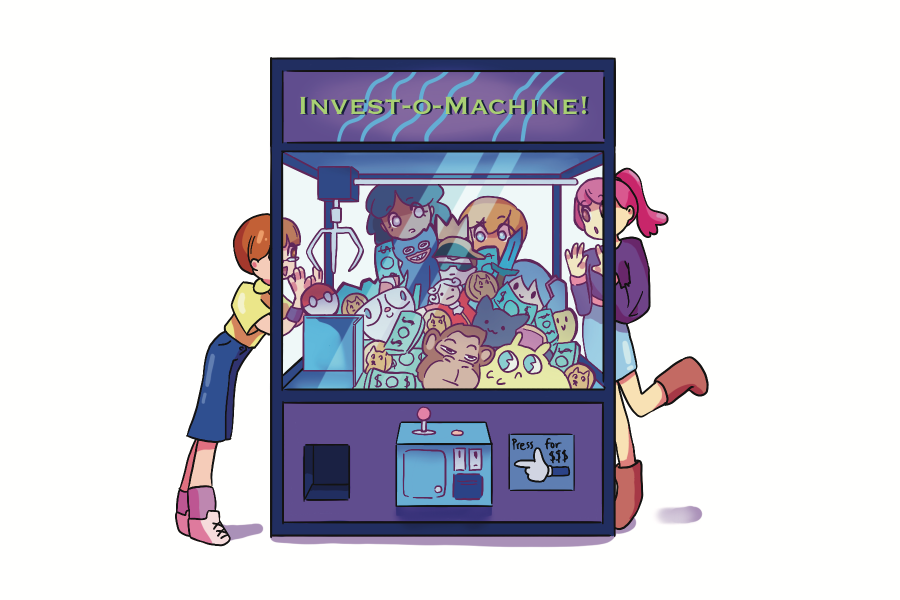Four heavy sighs break the library’s silence, drawing looks from nearby tables directed toward the crowd of juniors hovering around a computer lined with red. Just a few seconds ago, the S&P 500, an index of the 500 biggest stocks in the U.S. stock market, made the computer glow green.
Each of the students return to their seats, typing furiously as they attempt to sell their shares in individual index funds before losing thousands of more dollars. The money, however, is fake.
The surge in student investment, fueled by new mediums of investing including non-fungible tokens and cryptocurrencies, continues to inspire student groups to promote investing in high school. After participating in the market simulation organized by one of these groups, the Financial Intelligence for Teens non-profit, junior Sophia Kim organized a similar game for her friends using the website MarketWatch. The simulation provides each player with $100,000 in virtual money to invest in a virtual market that reflects the real stock market. Starting off with three of her friends, Kim said the allure of investing led her to quadruple the amount of players in her game in less than one week.
“(Investing) is almost like gambling where you can make or lose money with very little effort,” Kim said. “The thrill of that is enticing for a lot of people, especially in the Bay Area, since there is a possibility that you could make money.”
Gunn sophomore Gabby Skinner is the CEO of Invest Bright, an organization that teaches middle and high schoolers financial literacy. She said she attributes the surge in the popularity of investment to many students’ financial safety nets and lack of risk involved.
“That low-stakes time to start experimenting (with investing) is high school because you’re not an adult yet, and you don’t have to worry about your other assets like a house or car,” Skinner said. “You can start working, get a bit of money, and if it goes well, you can make a lot of money, and that could help you a lot in the future. If it doesn’t go well, you’re a high schooler, and it’s OK, you lost a bit of summer job money.”
Students, however, are not only investing in the stock market; some have placed their money in cryptocurrencies and non-fungible tokens.
Though NFTs and crypto are both based on blockchain technology, the latter is often thought of as an alternative form of money while NFTs can represent unique assets like art or music.
Although NFTs offer students the ability to invest in collectibles, Skinner said students new to finance should avoid investing in them.
“The stock market is reliable since it is government backed,” Skinner said. “In general, (while) it’s best to learn about NFTs as a young person just coming into the finance world, it is important to know the basics about the stock market first.”
From a student investor’s perspective, Kim agrees and said NFTs and cryptocurrency are too risky for her to invest in.
“It’s a little bit too volatile for me to be spending my own money, but I am really interested in those analytical funds,” Kim said. “Right now, I will be exploring those funds with fake money or through simulations.”
In the university’s newsroom questionnaire, UC Berkeley professor Christine Parlour addressed concerns about NFTs’ volatility and lack of regulation by saying cryptos will be managed by exchange-traded funds in the future.
“We have a lot of attempts to start up exchange-traded funds that track cryptos, and these are under the usual regulatory umbrellas,” Parlour said.
These ETFs provide investors with data about the price movements of cryptocurrencies, which helps with the volatility. As for the lack of regulation, several cryptocurrency ETFs since October 2021 have been formally approved by the U.S. Securities and Exchange Commission.
Kim and Skinner, however, said students must make an independent decision about their risk tolerance once they have an understanding of financial literacy.
“You should analyze individual funds and understand if they’re doing well or not, or else you’re just choosing your favorite companies,” Skinner said. “It’s important to research and talk to people around you.”
Kim also said though Living Skills classes touch on personal finance, PAUSD should consider adding classes to promote financial literacy as revised and specialized content would benefit the student body in the long run.
“There isn’t any mandated (financial literacy) class besides Econ,” Kim said. “Given that (finance) is something the vast majority of Americans have to work with as adults, it’s good to understand how stocks work. Without it, people can spend too much money or take big risks since they don’t understand the trade-off, or they don’t rationalize beforehand. It can be easier to make big decisions as a kid knowing that you have a big safety net under you, and that can be dangerous.”
Kim said to get involved with investing, students should consider which form best fits their schedules and then experiment with a simulation before investing real money.
“Familiarize yourself with the types of investing and funds out there,” Kim said. “There are long-term funds or investing styles, and then there’s also day trading or hybrids. I would say play it safe, and if you want to explore the risky side, you can do so in a simulation.”


